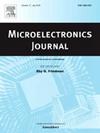Interrupted field-stop layer reverse conducting MOS controlled thyristor and mitigation of the voltage snapback
IF 1.9
3区 工程技术
Q3 ENGINEERING, ELECTRICAL & ELECTRONIC
引用次数: 0
Abstract
MOS controlled thyristor (MCT) can be widely used in pulse power systems for its high blocking voltage, high current rise rate and low on-state resistance. However, the extremely high changing rate of current will cause an unacceptable voltage across the parasitic inductance introduced by the freewheeling diode. To deal with this problem, we proposed the interrupted field-stop (FS) layer reverse conducting MCT (IF-RC-MCT) and demonstrated it by simulation. Owing to the potential barrier for electrons formed between the FS layer and N- region and the oxide trench, the voltage snapback resulted from the transition from MOS mode to IGBT mode is suppressed. The proposed IF-RC-MCT had a satisfactory behavior for the peak current of 1055 A, current rise rate of 3676 A/us, and reverse mode voltage drop of 2.2 V. The IF-RC-MCT structure shows a great promise for the application in pulse power systems.
中断场停止层反导MOS控制晶闸管及电压回跳的缓解
MOS控制晶闸管(MCT)具有高阻断电压、高电流上升速率和低导通电阻等优点,可广泛应用于脉冲电源系统中。然而,极高的电流变化率将导致一个不可接受的电压通过寄生电感引入自由旋转二极管。为了解决这一问题,我们提出了中断场停止(FS)层反导MCT (IF-RC-MCT),并进行了仿真验证。由于在FS层和N区以及氧化物沟槽之间形成了电子的势垒,从MOS模式过渡到IGBT模式所产生的电压回跳被抑制了。所提出的IF-RC-MCT的峰值电流为1055 a,电流上升速率为3676 a /us,反向电压降为2.2 V。IF-RC-MCT结构在脉冲电源系统中具有广阔的应用前景。
本文章由计算机程序翻译,如有差异,请以英文原文为准。
求助全文
约1分钟内获得全文
求助全文
来源期刊

Microelectronics Journal
工程技术-工程:电子与电气
CiteScore
4.00
自引率
27.30%
发文量
222
审稿时长
43 days
期刊介绍:
Published since 1969, the Microelectronics Journal is an international forum for the dissemination of research and applications of microelectronic systems, circuits, and emerging technologies. Papers published in the Microelectronics Journal have undergone peer review to ensure originality, relevance, and timeliness. The journal thus provides a worldwide, regular, and comprehensive update on microelectronic circuits and systems.
The Microelectronics Journal invites papers describing significant research and applications in all of the areas listed below. Comprehensive review/survey papers covering recent developments will also be considered. The Microelectronics Journal covers circuits and systems. This topic includes but is not limited to: Analog, digital, mixed, and RF circuits and related design methodologies; Logic, architectural, and system level synthesis; Testing, design for testability, built-in self-test; Area, power, and thermal analysis and design; Mixed-domain simulation and design; Embedded systems; Non-von Neumann computing and related technologies and circuits; Design and test of high complexity systems integration; SoC, NoC, SIP, and NIP design and test; 3-D integration design and analysis; Emerging device technologies and circuits, such as FinFETs, SETs, spintronics, SFQ, MTJ, etc.
Application aspects such as signal and image processing including circuits for cryptography, sensors, and actuators including sensor networks, reliability and quality issues, and economic models are also welcome.
 求助内容:
求助内容: 应助结果提醒方式:
应助结果提醒方式:


